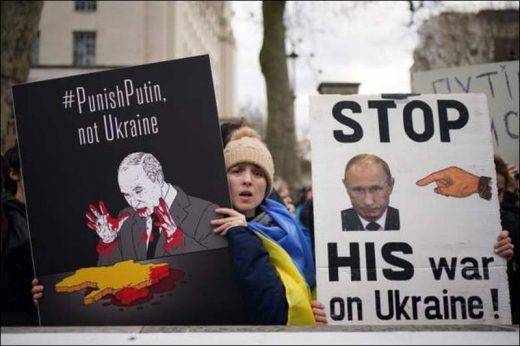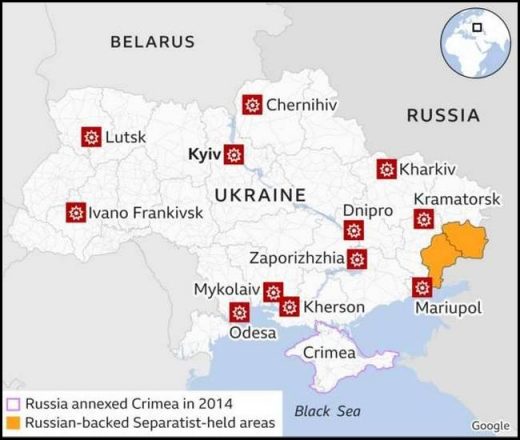The Russia-Ukraine war left its mark on the world agenda. After days of tension and negotiations, while the situation in the region was curious, Russia launched a military operation in Donbas on the morning of February 24. So, why did the Russia-Ukraine war begin? Why does Russia want to fight? Here are the reasons for the war.
The first news of loss of life in the Russia-Ukraine war began to come. While news of the explosion came from Donbas in the morning, the eyes of the world were turned to the region. President of Ukraine Vladimir Zelenskiy stated that he met with US President Joe Biden, German Chancellor Olaf Scholz, European Union (EU) Council President Charles Michel, Polish President Andrzej Duda, Boris Johnson. While all this was happening, the reasons for the Russia-Ukraine war began to be investigated by many people.
Why does Russia want to make war?
The tension between Russia and Ukraine dates back to the Middle Ages rather than recent history. Putin often describes Russia and Ukraine as “one people”, because they have a common past even though it is full of crises.
After the collapse of the Soviet Union in 1991, Russia, Ukraine and Belarus formed the Commonwealth of Independent States. With this union, Russia aimed both to maintain its influence and to reconnect the countries to itself through cheap natural gas supply. However, as Belarus entered into a close alliance with Moscow, Ukraine turned its direction more and more towards the West over time.
The unnamed tension between the two countries reached a critical threshold in 2014. Russia took advantage of the authority vacuum in Ukraine and annexed Crimea in 2014. There were also clashes between the pro-Russian separatists supported by Russia and the Ukrainian army in Donetsk, which is located in the east of Ukraine and on the Russian border. Among the citizens living in Ukraine, whose position is between Russia and Europe, there were polarizations as pro-Western and pro-Russian.
Western countries believe that Russian President Vladimir Putin is planning to overthrow the pro-Western government in Ukraine and replace it with a pro-Russian government.
The war is officially started
After annexing Crimea in 2014, Russia, which received a reaction from the international community, launched a military operation against Donbas at 05:50 local time. Addressing the nation in the morning, Putin announced to his people and the whole world that an operation was carried out in Ukraine.
In his speech, Putin noted that this was not an invasion, but a “special military operation”. In addition, while saying that this situation is caused by Ukraine, he also underlined that Russia will defend itself in the face of threats.
In his speech, Putin stated that they have no intention of occupying the territory of Ukraine and said, “The purpose of the operation is to protect the lives of civilians.”
Calling on the Ukrainian soldiers to lay down their arms, the Russian leader said, “Your ancestors fought with the Nazis. Do not obey the Nazi junta in Kiev. Drop your weapons and go home,” he said.
Noting that the USA and NATO ignored Russia’s security demands, Putin said, “The people of Donbas turned to Russia for help. “The operation aims to protect people who have suffered under the pressure of the Kiev administration for 8 years,” he said.
Causes of the Russia – Ukraine war
The Russia-Ukraine crisis first began in Ukraine in 2014, when the pro-Russian government was overthrown. Taking advantage of the administrative vacuum in the country, Russia annexed Crimea. Unilateral independence was declared in Luhansk and Donetsk in Donbas.
The Donbas, with its coal mines and heavy industry, was a region of the Soviet economy. At the same time, Russia considers Donbas, where the Russian population is concentrated, as its own territory. Donbas is important for Russia both economically and socially.
In order to prevent the conflicts in Donbas, the Minsk agreement was signed between the representatives of Ukraine, Russia and OSCE member countries in 2014-15. However, the ceasefire was violated and the agreement collapsed completely as Russia recognized the separatist governments.
The crisis between the two countries flared up when Russia massed troops on the Ukrainian border. After Russia’s move, NATO and the United States responded by increasing arms aid to Ukraine and increasing their military presence in Eastern Europe.
Perceiving the participation of former Soviet countries in NATO as a security threat, Russia sees Ukraine’s membership in NATO as a “red line”
Views: 127





